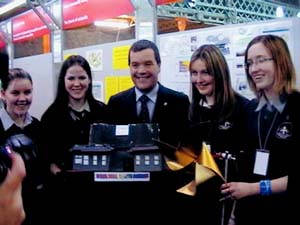| 2004 |

|
YEAR BOOK |
Pobalscoil Ghaoth Dobhair, Leitir Ceanainn
|
Alternative energy source for school use
|

We purchased an anemometer, and took daily wind speed-readings from the roof at the same time each day over a three-month period, September-December. We also used a pair of 2 inch x 2 inch (5cm x 5cm) solar panels attached to a multimeter. The readings were taken on a daily basis.
What our research indicated was that wind energy was a viable alternative to fossil fuels: where the problems arose were in the initial outlay costs and also public perception. The time frame for recouping these costs ran into many years and therefore did not make it an attractive option for a school of our size. In a survey of residents adjoining the school, it soon became clear that, while in general people were not opposed to wind energy, it was very much 'not in our back yard'. The question of interference to television reception and the need for larger aerials to be erected further added to the cost: whose responsibility was it to erect these?
The solar energy readings indicated that the energy output would not be sufficient to be a stand alone energy source, in spite of the fact that Ireland has a higher solar energy output than Paris. Along side this was the sheer size of the panels involved and again the prohibitive cost of these.
Overall our research showed that both are viable alternatives to fossil fuels: the problems lie in the high costs involved in harnessing this energy and in the public's perception.
Aoife N� Shearcaigh, Shauna N� Dhubhaigh & Louise N� Fhearraigh entered their project in the Intermediate Group Section in the Chemical, Physical and Mathematical Sciences Category at the EsatBT Young Scientist and Technology Exhibition in January 2004. They won a Special Award presented by Comhar � The National Sustainable Development Partnership. Their teacher was Mr Nigel � Fearraigh.
|
This article was sponsored by Comhar
The National Sustainable Development Partnership |
|---|